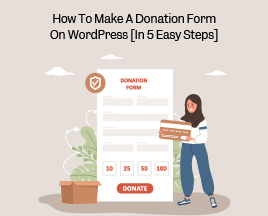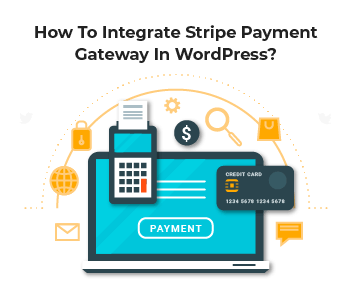It is a prevalent fact that a payment form is a dedicated place where the customer can easily decide your trustworthiness and vice versa. For a moment, the users take a break from sending you their hard-acquired money.
Also, you can add a Stripe or PayPal link on your page, enabling your customers to identify you and figure out how it works. Still, if you really want to leverage conversions, you need to have complete authority over the entire payment process. This is why we recommend using a tool such as WP Formify. You’ll get the simplicity and convenience of Stripe along with complete control over your forms. Hence, the steps below will be helpful for you to design your payment form in nine simple steps:

Keep Customers on Your Site
As intimated, you might spend a lot of time and energy getting people on your website, so it’s wasteful to send them to another website to complete a payment form. After you’ve finished the payment process, there’s always a good chance they won’t bother returning to your site to proceed with exploring your content in multiple ways.
Several payment processors require your customers to submit their payment details or relevant information on their website. Using Stripe and WP Formify, your potential customers can process all their payments on your website.
Provide Multiple Payment Methods
Approximately 56% of individuals expect businesses to provide a wide variety of payment options at the checkout. And yet there are still multiple websites that only accept one form of payment, and such sites are leaving money on the table.
You don’t have to offer each possible payment method, but it is essential to provide those your customers are most likely to prefer. Another reason Stripe is useful is that it can be easily integrated into multiple payment plugins, i.e., WP Formify, ensuring the seamless and progressive acceptance of multiple payment types.
Doesn’t Require an Account
Authorizing people to set up an account before making any purchase is a seamless and robust way to frustrate potential customers and transit sales. According to the reports, certain individuals conducted a usability study. They understood that people dislike setting up accounts because they usually worry they’ll be flooded with promotional emails. Purposefully, that is also considered a reasonable concern because it happens at the same time interval. Your customers don’t want another username and password to remember, and they often don’t feel the need to create an account because they wouldn’t have to in a brick-and-mortar store.
Also, they worry that if they create an account, you’ll just collect a bunch of data on them again, which is a perfectly reasonable concern because it happens all the time. Always make your customers’ lives easier by letting them check out as guests. If you use WP Fomify, your customers don’t have to set up an account to buy.
Ensures Customers Their Data is Safe & Secure
According to the reports, 58% of the respondents abandoned a payment form based on security concerns. At a specific age, where their financial information is consistently stolen and abused at a particular age, they’re right to be quite fearful. You can ensure that your customers feel comfortable about providing their financial details by adding the following information:
- Ensure they are on your website (rather than a third-party website).
- Install an SSL certificate on your website, so all information that goes back and forth is encrypted.
- Comply with the PCI Security Standards Council (PCI SSC). In particular, your payment methods manage this, but check with them to ensure it.
Ask Simplistic and Logical Questions
Payment forms are not the right place for ambiguous questions or hard-to-decipher language. If your potential customers don’t know how to answer your questions, they’ll definitely buy somewhere else. If you’re looking at this form’s language, the phrase “we would like to know” is considered unnecessary because the company wants to know or delve into your situation.
“Prefer” in the second question in confusing patterns and vice versa. When do we order the selected box? If the business isn’t delved into, will it get a different kind? “Please select your preference below.” is unnecessary, or vice versa. You need to simplify and limit your questions wherever it seems to be possible. You don’t need to give them a paragraph when a sentence will provide further information. Before publishing your form, have a friend or a colleague read it once. You need to ask them if they understand exactly what you’re looking for.
Delete Unnecessary Fields
With the passage of time, your customers decide to spend money with your business. The foremost thing you can do is to proceed ahead in a specific way. This means that you should avoid placing unnecessary obstacles before them, such as form fields that aren’t necessary for the users.
A recent study by Google has revealed that people often view complex design as an unappealing and unparalleled way to get ahead. Consequently, users prefer to interact with multiple websites that are very simple and easy to use. In today’s market segment, it’s quite tempting to collect a small amount of information that you can use later. You may want to use that specific data to segment and personalize your marketing activities. For the sake of conversions now, it’s always preferable to reduce your payment forms as much as possible.
Identify Customer’s Redundancies and Errors
Inevitably, people usually make mistakes when filling out forms; sometimes they forget a digit in their credit card number or neglect the “.com” in their email address. Whenever they submit a field improperly, you’ll have to ensure that they can fix their specific mistake. After you refresh your payment form, always ensure that it doesn’t clear the customer’s relevant information.
They’ll tend to be more frustrated if they have to complete the entire form process again as a whole because they made a mistake in a single field. Furthermore, you need to display the error message in the incorrect field or just beneath it. If the error message displays at the top or bottom of the form, the customer won’t understand that they have made a mistake in a single field. You need to pay attention to how this form makes it clear which field is the problem so that customers can quickly and painlessly fix it.
Highlights a Clear Call to Action
If your customers tend to finish inputting their information, you don’t want them to wonder about the next time. The final step in designing the perfect payment form is to give your customers a clear call-to-action button.
Using seamless color is something that complements your website’s theme while still standing out.You need to avoid ambiguous phrases such as “Next” or “Continue” in correspondence in favor of clear language such as “Check Out,” “Placement of Order,” or “Submission of the Payment.”
Build a Thank You Page
Consequently, a “Thank you for your payment” popup isn’t considered sufficient. You need a particular page on your website that ensures your new customers tend to be more comfortable with their purchases. You need to keep in mind that they still have a little anxiety about spending their money. To create a relationship, you should create a landing page that relies on the following aspects:
- Thank them explicitly for their purchases.
- Confirm any essential details.
- Inform them about the forthcoming steps.
- Provide them with relevant ways to interact with your brand, such as following you on social media, reading your blog content, or subscribing to your newsletter.
Conclusion
In a nutshell, the aforementioned discussion provides you with certain tips and tricks that help you design intuitive payment forms. Still, if you want to maximize conversions, it’s essential to develop a payment exposure that your customers tend to prefer. This means that you’ll have to perform an A/B test on your forms until you find the ones that easily convert the most of them. Use WP Formify if you want to make your payment process more reliable. You can use it to plan your payment form so that payments go smoothly.



